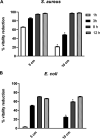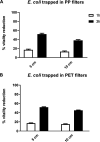Positive and Negative Ions Potently Inhibit the Viability of Airborne Gram-Positive and Gram-Negative Bacteria
- PMID: 34756075
- PMCID: PMC8579920
- DOI: 10.1128/Spectrum.00651-21
Positive and Negative Ions Potently Inhibit the Viability of Airborne Gram-Positive and Gram-Negative Bacteria
Abstract
Positive and negative ions (PAIs and NAIs, respectively) generated by air ionizers curb indoor spread of airborne pathogens through cellular oxidative damage. Thus, here, we asked whether ion exposure of Staphylococcus aureus and Escherichia coli bacteria-either plated on agar or trapped in air filters-would affect their viability and whether this effect would be influenced by variations in bacterial type and load, action area, distance from the ion generator, exposure time, or filter type. We selected these two vegetative bacterium species because, besides being representative of Gram-positive and Gram-negative strains, respectively, they are widely recognized as the two most common airborne pathogens. We observed a robust ion inhibitory effect on the viability of free bacteria regardless of the experimental condition employed. Specifically, 12-h ion exposure of plated S. aureus and E. coli, at either 5 cm or 10 cm from the ion source, reduced bacterial viability by ∼95% and 70%, respectively. Furthermore, 3-h ion exposure was sufficient to reduce the viability of both bacterial species trapped in filters. Our results showing a strong antibacterial activity of PAI and NAI under all experimental conditions tested further support the use of air ionizers for preventing and/or containing airborne infection in domestic and nondomestic settings. IMPORTANCE Indoor air is a well-established vehicle for direct and indirect spread of a wide variety of human pathogens-as bioaerosols are composed of bacteria, viruses, fungi, and other types of organisms-that may trigger some pathologies. Plasmacluster ionizers are known for their ability to generate positively or negatively charged air ions (PAIs and NAIs, respectively) that can kill/inactivate indoor airborne pathogens, through oxidative stress-induced damage, in various environments. Given these premises, the aim of this study was to evaluate the viability of Gram-positive and Gram-negative bacteria exposed to PAI and NAI under different experimental variables such as bacterial type and load, action area, distance from the ion generator, ion exposure time, and filter type. Altogether, our findings, demonstrating a remarkable PAI and NAI antibacterial activity, stress the importance of using air ionizers to prevent indoor airborne infection.
Keywords: Escherichia coli; Staphylococcus aureus; air filters; air ionizer; antibacterial activity.
Figures




Similar articles
-
Air cleaning technologies: an evidence-based analysis.Ont Health Technol Assess Ser. 2005;5(17):1-52. Epub 2005 Nov 1. Ont Health Technol Assess Ser. 2005. PMID: 23074468 Free PMC article.
-
Inactivation of S. epidermidis, B. subtilis, and E. coli bacteria bioaerosols deposited on a filter utilizing airborne silver nanoparticles.J Microbiol Biotechnol. 2008 Jan;18(1):176-82. J Microbiol Biotechnol. 2008. PMID: 18239437
-
The bactericidal effect of an ionizer under low concentration of ozone.BMC Microbiol. 2016 Jul 30;16(1):173. doi: 10.1186/s12866-016-0785-5. BMC Microbiol. 2016. PMID: 27475908 Free PMC article.
-
Should homes and workplaces purchase portable air filters to reduce the transmission of SARS-CoV-2 and other respiratory infections? A systematic review.PLoS One. 2021 Apr 29;16(4):e0251049. doi: 10.1371/journal.pone.0251049. eCollection 2021. PLoS One. 2021. PMID: 33914823 Free PMC article.
-
Generic aspects of the airborne spread of human pathogens indoors and emerging air decontamination technologies.Am J Infect Control. 2016 Sep 2;44(9 Suppl):S109-20. doi: 10.1016/j.ajic.2016.06.008. Am J Infect Control. 2016. PMID: 27590695 Free PMC article. Review.
Cited by
-
Mechanism of the Huangguoshu waterfall forest environment's promotive effect on human health in Guizhou, China.Ann Transl Med. 2022 Aug;10(16):894. doi: 10.21037/atm-22-3787. Ann Transl Med. 2022. PMID: 36110995 Free PMC article.
-
Airborne Microorganism Inactivation by a UV-C LED and Ionizer-Based Continuous Sanitation Air (CSA) System in Train Environments.Int J Environ Res Public Health. 2022 Jan 29;19(3):1559. doi: 10.3390/ijerph19031559. Int J Environ Res Public Health. 2022. PMID: 35162585 Free PMC article.
-
Efficient deactivation of aerosolized pathogens using a dielectric barrier discharge based cold-plasma detergent in environment device for good indoor air quality.Sci Rep. 2023 Jun 25;13(1):10295. doi: 10.1038/s41598-023-37014-2. Sci Rep. 2023. PMID: 37357240 Free PMC article.
References
-
- Sulman FG. 1980. The effect of air ionization, electric fields, atmospherics, and other electric phenomena on man and animal. Charles C. Thomas Publisher, Springfield, IL.
-
- Parts T-E, Luts A. 2004. Observed and simulated effects of certain pollutants on small air ion spectra. I. Positive ions. Atmos Environ 38:1283–1289. doi:10.1016/j.atmosenv.2003.11.030. - DOI

